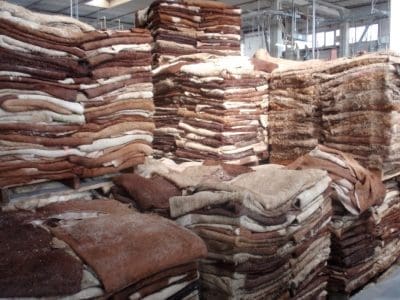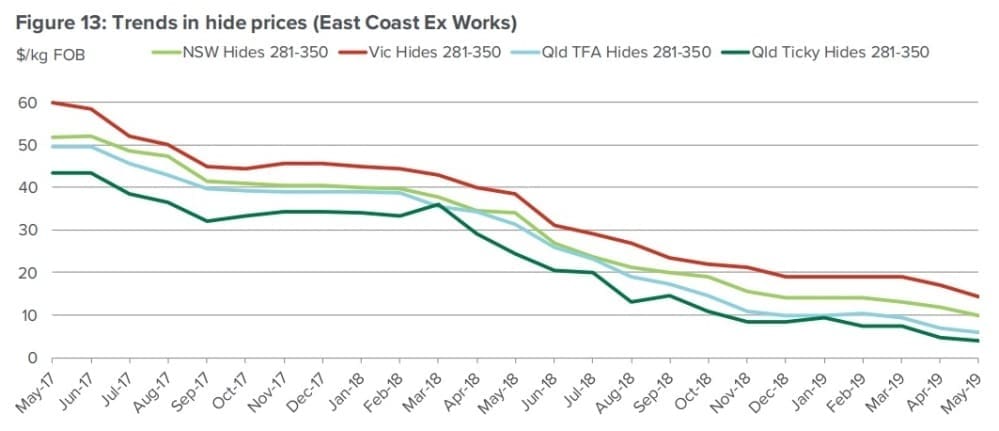THE global market for cattle hides continues to plummet to new depths, driven by a range of powerful supply and demand factors – the latest of which is the trade standoff between the US and China.
Hide values in Australia have now slipped well below their previous lowest demand-point, seen during the 2007 Global Financial Crisis, trade sources said on Friday.
 Beef Central filed this report on the poor state of the hides market and the reasons behind it last year, but prices and outlook have continued to deteriorate since then.
Beef Central filed this report on the poor state of the hides market and the reasons behind it last year, but prices and outlook have continued to deteriorate since then.
Because of the popularity of leather in the fashion world (handbags, shoes and accessories); the luxury motor vehicle trade (leather seats); and the furniture market, the state of the leather market is often seen as a litmus test for the world economy.
A number of factors are impacting values:
- Global economic and trade issues, including the US/China tariff war
- The development of much more ‘convincing’ synthetic leather products
- A slowdown in luxury car manufacture, with a 10-15pc reduction in the past 12 months
- Large end-customers like footwear manufacturer Nike, which plans to remove leather altogether from its products, replaced by synthetic materials made from recycled plastics.
- Increased environmental regulation in China, which has forced thousands of small ‘backyard’ tanneries to close
- High levels of hide production out of North and South America.
Australian hide prices in June fell a further 10-20 percent for all categories on the month prior, and are now 50-90 percent below where they sat in June last year (see MLA graph below).

Good quality, machine-pulled large hides (from cattle 350kg carcase weight or heavier) in Victoria last month averaged just over $20/hide, while the same category in NSW averaged $17 in June, and just under $10/hide in Queensland. At the peak of the market back in 2014, best quality large Victorian hides were worth up to $110 each.
Many hides from cattle less than 350kg carcase weight are now making less than $10/hide, with some small or lesser-quality hides reportedly holding no market value whatsoever.
So severe has the price decline been that processors with lower quality hides in some cases are working on ‘least loss’ sums, rather than holding any expectation of profit.
In rough terms, industry sources have told Beef Central it costs around $7-$10 to salt and pack hides for sale to overseas tanners. That’s before transport, which can easily cost another $2-3/hide, depending on location. With many less desirable ticky cattle hides now worth only $5-7 or less, it means processors in some areas are well into loss on their hides trade.
“It’s just diabolical – we’ve never seen it so bad,” one large multi-state export processor told Beef Central on Friday.
Poorer quality hides are being worst hit – a commodity Australia is producing a lot of at present, due to the inflated rate of cull cow slaughter due to drought.
Several options being explored
Apart from selling hides at a loss, several options are being explored by owners, Beef Central was told:
- There’s clear evidence that poorer quality less desirable hides (from light–conditioned cows, for example) are simply being dumped as landfill. Even that carries an environmental management regulatory cost, however, and the cost rises, the larger the volume involved. “Some owners have done their calculations and have found it is cheaper to cop a loss on selling hides into the traditional market, rather than dumping them as landfill, with the associated environmental costs,” a trade source said.
- Some owners are salting down and stockpiling hides, in the hope that prices may revive at some future time. Hides will easily store for 12-24 months in a salted state, but storage capacity quickly becomes an issue, given that Australia currently generates around 150,000 bovine hides (called ‘pieces’ in the trade) each week. Worldwide, there are reports of hides being stockpiled due to price declines. Most Australian hides producers have little storage capacity, and are forced to continue to turn stock over, virtually regardless of price. And trade participants say a large stockpile of hides will do nothing for price discovery, if prices do start to rise again. “The best we can hope for now is for stockpiling to stop, and whatever is now in store is whittled away over the next 12 months,” one hides merchant contact said on Friday.
- Rendering of hides is also being discussed in some circles. Cattle hides are not typically rendered in Australia, but the practice is seen in some overseas countries, Beef Central was told. An estimated 10pc of hides in the US presently go into rendering, rather than leather production. However the energy and associated costs in rendering may well exceed the current value of some lesser quality Australian hides, sources said.
Impact on livestock prices
The impact of the big devaluation in hides is important for the broader beef industry, because hides form a part of each animal’s so-called ‘fifth quarter’ which contribute to the processor’s return from each animal purchased, and ultimately to their ability to pay for livestock.
Beef Central asked one export processor who markets their own hides whether current livestock prices fully reflected the state of the hides market.
“In the previous few months, it was probably being overlooked, because meat prices were so good – which softened the blow,” he said. “But international meat prices are falling now, and its bringing the hides value component back into the spotlight,” he said.
Tanneries are currently closing overseas due to lack of leather demand, and many hide traders are said to be under ‘enormous pressure,’
“Buyers in China are using numerous strategies, as the market continues to fall. The first is slapping in a claim on the quality of the hides, when they arrive, to further reduce price; the second is to simply try to cancel orders that are on the water, to hold the supplier to ransom; and the third is buying one consignment at a reasonable price, but seeking an extreme discount on the next, to compensate,” Beef Central was told.
Adding to global hides challenges is high rates of beef kill in the US, recently above 650,000 head per week, and industry growth in Brazil and other parts of South America.
“There’s just too many hides being produced, worldwide, to match current very flat levels of demand,” a hides broker said.
He suggested Australian hides were at something of a disadvantage over supplies from other parts of the world, because China was leaning away from traditionally salted hides on environmental grounds, in favour of more wet-blue treated hides. Some large hides producing countries, like Brazil, produce a greater proportion of wet-blue (chemically treated and preserved) hides than Australia, because the Brazilian government earlier offered big subsidies to industry to build wet blue curing infrastructure.
“Go back 20 years or so, and cattle hides were worth about 10 percent of the overall animal value,” hides broker Ross Barker told Beef Central. “Hides value used to be a factor in what cattle were worth to a meat processor, but today it is becoming insignificant in the scheme of things,” he said.
“The only positive that can be found in the hides market at present is that hides are still being sold. The next step is that buyers say they don’t want them, at any cost,” Mr Barker said.
- Beef Central scrutinised the reasons behind the falling hides market in this story last year – “Global hides market a complex business, but China still drives the bus”



we are intested to buy cow rawhide ,
Hi ,
I want to start a business to export hide from Australia.
Could you suggest, is this a good business ? I have no knowledge about cowhide. I will be a buyer and exporter from QLD. I want to know more about price as well.
1. Double sodium fluoride and boric acid and salt really well.
2. Stock pile them cold stores
3. Price will triple eventually without doubt.
4. Need 24 month or so
The $10 gap in value between Victorian hides and Qld ticky hides ( $7-NSW) remains a significant opportunity loss for producers and processors. The economic loss in value from ticks must surely be enough to increase R&D funding to reducing or removing ticks from the production landscape- being born in the ticks is enough to carry this penalty forward for whole of life. Further Hide value improvement opportunities exist in size , placement and application of freeze or fire brands .